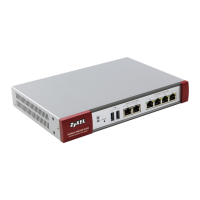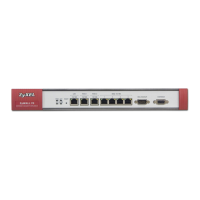Chapter 21 IPSec VPN
USG20(W)-VPN Series User’s Guide
334
Main Mode or Aggressive Mode. Main Mode protects the identity of the peers, but Aggressive
Mode does not.
During Phase 2, the remote IPSec routers use the secure channel established in Phase 1 to
negotiate Security Associations for IPsec. The negotiation results in a minimum of two
unidirectional security associations (one inbound and one outbound). Phase 2 uses Quick Mode
(only). Quick mode occurs after IKE has established the secure tunnel in Phase 1. It negotiates a
shared IPSec policy, derives shared secret keys used for the IPSec security algorithms, and
establishes IPSec SAs. Quick mode is also used to renegotiate a new IPSec SA when the IPSec SA
lifetime expires.
In the USG, use the VPN Connection tab to set up Phase 2 and the VPN Gateway tab to set up
Phase 1.
Some differences between IKEv1 and IKEv2 include:
• IKEv2 uses less bandwidth than IKEv1. IKEv2 uses one exchange procedure with 4 messages.
IKEv1 uses two phases with Main Mode (9 messages) or Aggressive Mode (6 messages) in phase
1.
• IKEv2 supports Extended Authentication Protocol (EAP) authentication, and IKEv1 supports X-
Auth. EAP is important when connecting to existing enterprise authentication systems.
• IKEv2 always uses NAT traversal and Dead Peer Detection (DPD), but they can be disabled in
IKEv1 using USG firmware (the default is on).
• Configuration payload (includes the IP address pool in the VPN setup data) is supported in IKEv2
(off by default), but not in IKEv1.
• Narrowed (has the SA apply only to IP addresses in common between the USG and the remote
IPSec router) is supported in IKEv2, but not in IKEv1.
• The IKEv2 protocol supports connectivity checks which is used to detect whether the tunnel is
still up or not. If the check fails (the tunnel is down), IKEv2 can re-establish the connection
automatically. The USG uses firmware to perform connectivity checks when using IKEv1.
SSL VPN
SSL VPN uses remote users’ web browsers to provide the easiest-to-use of the USG’s VPN solutions.
A user just browses to the USG’s web address and enters his user name and password to securely
connect to the USG’s network. Remote users do not need to configure security settings. Here a user
uses his browser to securely connect to network resources in the same way as if he were part of the
internal network. See Chapter 22 on page 368 for more on SSL VPN.

